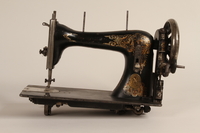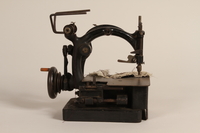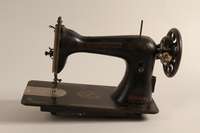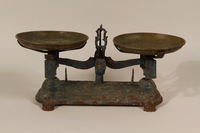Overview
- Brief Narrative
- Singer iron and wood sewing machine table of the type used in Łódź Ghetto in German occupied Poland from May 1940 to summer 1944. Łódź was occupied by Germany a week after the September 1939 invasion of Poland. It was renamed Litzmannstadt and, in February 1940, the Jewish population, about 160,000 people, was confined to a small sealed off ghetto. All residents had to work and many were forced laborers in ghetto factories. Eventually, nearly 100 factories were in operation. The major ones produced textiles, including uniforms for the German Army. Due to the severe overcrowding and scarce food, disease and starvation were common. The Judenrat [Jewish Council] administered the ghetto for the Germans. Judenrat chairman Mordechai Rumkowski thought hard work and high outputs would preserve the ghetto. But in January 1942, mass deportations to Chelmno killing center began; half the residents were murdered by the end of the year. In summer 1944, Łódź, the last ghetto in Poland, was destroyed and the remaining Jews were sent to Chelmno and Auschwitz-Birkenau killing centers.
- Date
-
use:
approximately 1930-1945
- Geography
-
manufacture:
United States
- Credit Line
- United States Holocaust Memorial Museum Collection
- Markings
- base, left side, embossed : THE SINGER MANFG. CO. / TRADEMARK
base, right side, embossed : THE SINGER MANFG. CO. / TRADEMARK
base, center, wrought : SINGER - Contributor
-
Manufacturer:
Singer Sewing Machine Corp.
Physical Details
- Language
- English
- Classification
-
Furnishings and Furniture
- Category
-
Tables
- Object Type
-
Tables (lcsh)
- Physical Description
- Brown, wooden treadle powered sewing machine table with black, cast iron, lattice work legs connected by a metal H cross brace. A large spoked wheel is attached to the right side and a rectangular lattice work treadle is attached near the bottom. The table has a flat, rectangular wooden top with a beveled edge and a hinged, 12 inch wide leaf on the left end, supported by a swinging cast iron bracket. In the center is a rectangular hole with 2 thick, metal mounting posts for a sewing machine on the inner edge. There is a thin, notched rectangular tray attached below to support the machine. The tray is flanked by support runners for 2 rectangular drawers. The right drawer has a decorative metal drawer; the left drawer is missing.
- Dimensions
- overall: Height: 29.000 inches (73.66 cm) | Width: 34.500 inches (87.63 cm) | Depth: 17.125 inches (43.498 cm)
- Materials
- overall : cast iron, wood, metal
Rights & Restrictions
- Conditions on Access
- No restrictions on access
- Conditions on Use
- No restrictions on use
Keywords & Subjects
Administrative Notes
- Legal Status
- Permanent Collection
- Provenance
- The table was acquired by the United States Holocaust Memorial Museum in 1990.
- Funding Note
- The cataloging of this artifact has been supported by a grant from the Conference on Jewish Material Claims Against Germany.
- Record last modified:
- 2023-03-06 11:37:11
- This page:
- https://collections.ushmm.org/search/catalog/irn4102
Download & Licensing
In-Person Research
- By Appointment
- Request 21 Days in Advance of Visit
- Plan a Research Visit
- Request to See This Object
Contact Us
Also in Eastern European sewing equipment collection
The collection consists of six sewing machines, treadle tables, and a scale used in Poland before, during, and after World War II.
Date: after 1916-before 1950

Singer style treadle sewing machine table of the type used in Łódź Ghetto
Object
Treadle sewing machines like this Singer model were used by Jewish forced laborers in Łódź Ghetto in German occupied Poland from May 1940 to summer 1944. This mass produced machine was very durable and affordable. Łódź was occupied by Germany a week after the September 1939 invasion of Poland. It was renamed Litzmannstadt and, in February 1940, the Jewish population, about 160,000 people, was confined to a small sealed off ghetto. All residents had to work and many were forced laborers in ghetto factories. Eventually, nearly 100 factories were in operation. The major ones produced textiles, including uniforms for the German Army. Due to the severe overcrowding and scarce food, disease and starvation were common. The Judenrat [Jewish Council] administered the ghetto for the Germans. Judenrat chairman Mordechai Rumkowski thought hard work and high outputs would preserve the ghetto. But in January 1942, mass deportations to Chelmno killing center began; half the residents were murdered by the end of the year. In summer 1944, Łódź, the last ghetto in Poland, was destroyed and the remaining Jews were sent to Chelmno and Auschwitz-Birkenau killing centers.

Treadle sewing machine with painted star of the type used in Łódź Ghetto
Object
Treadle sewing machines like this ladies' home model sewing machine were used by Jewish forced laborers in Łódź Ghetto in German occupied Poland from May 1940 to summer 1944. This mass produced machine was very durable and affordable. Łódź was occupied by Germany a week after the September 1939 invasion of Poland. It was renamed Litzmannstadt and, in February 1940, the Jewish population, about 160,000 people, was confined to a small sealed off ghetto. All residents had to work and many were forced laborers in ghetto factories. Eventually, nearly 100 factories were in operation. The major ones produced textiles, including uniforms for the German Army. Due to the severe overcrowding and scarce food, disease and starvation were common. The Judenrat [Jewish Council] administered the ghetto for the Germans. Judenrat chairman Mordechai Rumkowski thought hard work and high outputs would preserve the ghetto. But in January 1942, mass deportations to Chelmno killing center began; half the residents were murdered by the end of the year. In summer 1944, Łódź, the last ghetto in Poland, was destroyed and the remaining Jews were sent to Chelmno and Auschwitz-Birkenau killing centers.

Chain stitch sewing machine of the type used in Łódź Ghetto
Object
Chain stitch treadle sewing machines like this were used by Jewish forced laborers in Łódź Ghetto in German occupied Poland from May 1940 to summer 1944. Łódź was occupied by Germany a week after the September 1939 invasion of Poland. It was renamed Litzmannstadt and, in February 1940, the Jewish population, about 160,000 people, was confined to a small sealed off ghetto. All residents had to work and many were forced laborers in ghetto factories. Eventually, nearly 100 factories were in operation. The major ones produced textiles, including uniforms for the German Army. Due to the severe overcrowding and scarce food, disease and starvation were common. The Judenrat [Jewish Council] administered the ghetto for the Germans. Judenrat chairman Mordechai Rumkowski thought hard work and high outputs would preserve the ghetto. But in January 1942, mass deportations to Chelmno killing center began; half the residents were murdered by the end of the year. In summer 1944, Łódź, the last ghetto in Poland, was destroyed and the remaining Jews were sent to Chelmno and Auschwitz-Birkenau killing centers.

Soviet treadle sewing machine with Singer storage table of the type used in Łódź Ghetto
Object
Treadle sewing machines like this Russian model with Singer sewing table were used by Jewish forced laborers in Łódź Ghetto in German occupied Poland from May 1940 to summer 1944. These mass produced models were inexpensive and very durable. Łódź was occupied by Germany a week after the September 1939 invasion of Poland. It was renamed Litzmannstadt and, in February 1940, the Jewish population, about 160,000 people, was confined to a small sealed off ghetto. All residents had to work and many were forced laborers in ghetto factories. Eventually, nearly 100 factories were in operation. The major ones produced textiles, including uniforms for the German Army. Due to the severe overcrowding and scarce food, disease and starvation were common. The Judenrat [Jewish Council] administered the ghetto for the Germans. Judenrat chairman Mordechai Rumkowski thought hard work and high outputs would preserve the ghetto. But in January 1942, mass deportations to Chelmno killing center began; half the residents were murdered by the end of the year. In summer 1944, Łódź, the last ghetto in Poland, was destroyed and the remaining Jews were sent to Chelmno and Auschwitz-Birkenau killing centers.

Iron shop store hand scale with two copper trays
Object
Iron measuring scale with two copper trays of the type possibly used in Łódź Ghetto in German occupied Poland from May 1940 to summer 1944. Łódź was occupied by Germany a week after the September 1939 invasion of Poland. It was renamed Litzmannstadt and, in February 1940, the Jewish population, about 160,000 people, was confined to a small sealed off ghetto. All residents had to work and many were forced laborers in ghetto factories. Eventually, nearly 100 factories were in operation. The major ones produced textiles, including uniforms for the German Army. Due to the severe overcrowding and scarce food, disease and starvation were common. The Judenrat [Jewish Council] administered the ghetto for the Germans. Judenrat chairman Mordechai Rumkowski thought hard work and high outputs would preserve the ghetto. But in January 1942, mass deportations to Chelmno killing center began; half the residents were murdered by the end of the year. In summer 1944, Łódź, the last ghetto in Poland, was destroyed and the remaining Jews were sent to Chelmno and Auschwitz-Birkenau killing centers.
Treadle sewing machine table of the type used in Łódź Ghetto
Object
Wooden and cast iron sewing machine table top and base of the type used by Jewish forced laborers in Łódź Ghetto in German occupied Poland from May 1940 to summer 1944. Łódź was occupied by Germany a week after the September 1939 invasion of Poland. It was renamed Litzmannstadt and, in February 1940, the Jewish population, about 160,000 people, was confined to a small sealed off ghetto. All residents had to work and many were forced laborers in ghetto factories. Eventually, nearly 100 factories were in operation. The major ones produced textiles, including uniforms for the German Army. Due to the severe overcrowding and scarce food, disease and starvation were common. The Judenrat [Jewish Council] administered the ghetto for the Germans. Judenrat chairman Mordechai Rumkowski thought hard work and high outputs would preserve the ghetto. But in January 1942, mass deportations to Chelmno killing center began; half the residents were murdered by the end of the year. In summer 1944, Łódź, the last ghetto in Poland, was destroyed and the remaining Jews were sent to Chelmno and Auschwitz-Birkenau killing centers.
Pfaff industrial sewing machine with treadle of the type used in Łódź Ghetto
Object
Treadle sewing machines like this Pfaff industrial model were used by Jewish forced laborers in Łódź Ghetto in German occupied Poland from May 1940 to summer 1944. This mass produced machine was very durable and affordable. Łódź was occupied by Germany a week after the September 1939 invasion of Poland. It was renamed Litzmannstadt and, in February 1940, the Jewish population, about 160,000 people, was confined to a small sealed off ghetto. All residents had to work and many were forced laborers in ghetto factories. Eventually, nearly 100 factories were in operation. The major ones produced textiles, including uniforms for the German Army. Due to the severe overcrowding and scarce food, disease and starvation were common. The Judenrat [Jewish Council] administered the ghetto for the Germans. Judenrat chairman Mordechai Rumkowski thought hard work and high outputs would preserve the ghetto. But in January 1942, mass deportations to Chelmno killing center began; half the residents were murdered by the end of the year. In summer 1944, Łódź, the last ghetto in Poland, was destroyed and the remaining Jews were sent to Chelmno and Auschwitz-Birkenau killing centers.



